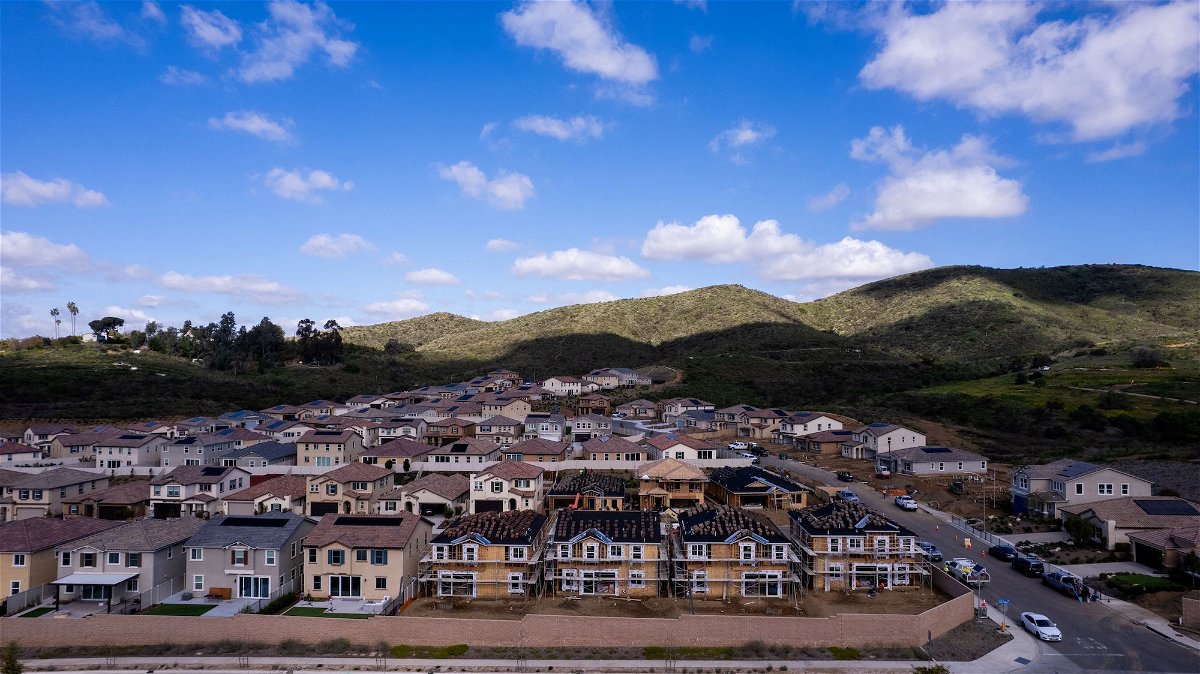US home prices rose in February at the fastest pace in more than a year

A drone view shows single-family homes at a new subdivision under construction in the rural hills of San Marcos
Washington (CNN) — US home-price growth accelerated in February at the fastest annual pace since November 2022, a sign that America’s housing market remains tough amid elevated mortgage rates.
The S&P CoreLogic Case-Shiller US National Home Price Index, a measure of home prices across the country, rose 6.4% in February from a year earlier, a bigger increase than the 6% registered in January. On a monthly basis, the index advanced a seasonally adjusted 0.4% in February.
The Case-Shiller 20-city index also jumped in February, to an annual gain of 7.3%, up from January’s 6.6% rise. Of the 20 cities, San Diego saw the biggest increase in home prices in February, a steep 11.4% rise, followed by Chicago and Detroit. Meanwhile, home prices in Portland, Oregon, are “still holding the lowest rank after reporting two consecutive months of the smallest year-over-year growth,” according to a release.
“US home prices continued their drive higher,” Brian Luke, head of commodities, real and digital assets, at S&P Dow Jones Indices, said in a release. “On a monthly basis, home prices continue to struggle in the face of elevated borrowing costs. Seventeen markets dropped over the last month, while Minneapolis has posted a 2.4% decline over the prior three months.”
He added that “only Southern California and Washington, DC, have stood up the rising wave of interest rates and deliver positive returns to start the year.”
‘Buyers have been priced out of the market’
America’s housing market began to recover in the beginning the year as home sales surged from decades-lows in the fall and homebuilders began to feel to more upbeat about the economy. There were also high hopes that the Federal Reserve would cut interest rates several times starting in the spring. That momentum seems to have fizzled out.
Existing home sales, which make up the vast majority of the housing market, fell sharply in March as home prices continued to rise that month, according to data from the National Association of Realtors. Residential construction of single-family homes also dropped sharply in March, according to government figures, declining 12.4% to a seasonally adjusted annual rate of 1.022 million units.
Inflation also proved to be much more stubborn than Wall Street and the Fed previously expected, which was sent bond yields surging since it means the Fed won’t be in a rush to cut interest rates.
The benchmark 10-year US Treasury yield closed above 4.7% last week, the highest level since November. Mortgage rates have followed suit, since they track the 10-year yield. The 30-year fixed-rate mortgage averaged 7.17% last week, a peak for the year and the highest level since November, according to Freddie Mac data. Economists don’t expect mortgage rates to drop meaningfully this year, and they could continue to climb if inflation remains stuck.
Mortgage rates play an important role in determining affordability, in addition to home prices and family incomes. That’s proving to be a key sticking point for potential homebuyers.
A separate gauge of home prices by Moody’s Analytics released Monday showed there was a slowdown in prices last month. The Moody’s Analytics House Price Index rose 0.12% in March, which was “the slowest pace of monthly gains in more than a year,” according to a release.
Still, despite the shred of good news provided by that measure, the US housing market remains woefully difficult for buyers because of high mortgage rates, Matthew Walsh, a Moody’s Analytics housing economist, said in a release.
“Many potential buyers have been priced out of the market,” Walsh said.
Some good news on housing
One unmistakble improvement in the housing market has been the increase in housing investory over the past few months, according to NAR data.
Inventory of unsold homes rose 4.7% in March from the prior month to 1.11 million units, and was up 14.4% from a year earlier, NAR reported earlier this month. More homes came to market in February, too.
It’s a step in the right direction, but supply still isn’t keeping up with demand. The persistent undersupply of housing can be attributed to various reasons, but a big one has been that some homeowners are choosing not to sell because they want to hold on to their low mortgage rate. That is still limiting affordability.
“Home sales are stuck because interest rates have not made any major moves,” NAR chief economist Lawrence Yun said earlier this month. “We need more inventory, definitely.”
The-CNN-Wire
™ & © 2024 Cable News Network, Inc., a Warner Bros. Discovery Company. All rights reserved.